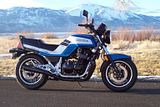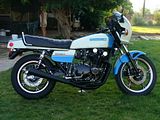Does the clutch need breaking in? Will it get better, or is something wrong? The new clutch kit is from Moto Technica, plates and heavy duty springs.
Announcement
Collapse
No announcement yet.
New clutch break-in?
Collapse
X
-
New clutch break-in?
I installed new clutch plates on my 78 GS1000. Now when I put in in gear, it rolls even with the clutch pulled all the way in and me on the bike. It will stall if I put the brakes on to keep it from rolling. I checked the linkage and all is good there. It is pulling all the way in.
Does the clutch need breaking in? Will it get better, or is something wrong? The new clutch kit is from Moto Technica, plates and heavy duty springs.Tags: None
-
Forum GuruCharter Member
GSResource Superstar
Past Site Supporter- Oct 2002
- 8858
- Angeles Forest, So.Calif./Red rocks of Southern Utah.
You're saying the clutch is dragging? It drags and lurches forward when tapping into gear?
Most noticable when oil is colder?
On my 1000, with a V&H welded/modified clutch basket, I experienced dragging on initial start up after my restoration. The clutch plates may break in a little but they should do so immediately. My dragging didn't go away. I don't know what happened during the rebuild or if it has something to do with the new plates, but I found that changing the oil from 20/50, back to the factory recommended 10/40 mostly fixed my problem. I still got a slight drag in the morning but exercizing the clutch lever a few times eliminates any slight drag/lurching. Shifting is good.
I preferred the 20/50 but just can't use it now. It was also making shifting a little harder. I wanted 20/50 mostly for summer riding, but fresh 10/40, especially with an oil cooler, works fine.
Actually, I broke in my new engine with straight 30 wt, as recommended by V&H. So the initial drag was with 30 wt. I insisted on a break in for about 750 miles with this oil. I was able to live with the clutch problem during that time. When I changed to my normal 20/50, the shifting got harder and the dragging stayed. I knew oil viscosity could cause this and I went back to 10/40 and things worked pretty good then. I did check the clutch completely before going back to 10/40.
In your case, it may be your oil too.
But first, you do have the correct slack in the cable (2-3mm) at the lever pinch point? Cable routing is VERY important too on this model. Route it exactly as the factory manual shows. Brand of cable can matter too.
Is the clutch cable/pinion rack arm pointing in the correct position? About 9:00? You should always turn the pinion arm clock-wise until it stops under normal finger strength, then attach the arm at 9:00 and hook up the cable. If the cable is new, especially cheaper cables, you'll get some early stretching. But if all the adjustments above are made, I'll bet it's your oil.And on the seventh day,after resting from all that he had done,God went for a ride on his GS!
Upon seeing that it was good, he went out again on his ZX14! But just a little bit faster!
-
Did you soak the plates before installing them?
This is an old trick I was taught years ago.
Soaking the fiber plates for a few hours before installing, in oil of course.
Also what clutch?
When I installed a Barnett clutch kit in my 100S, I was frustrrated with it
not relaeasing. The kit had an extra plate and with the heavier springs it would drag.
Took a bit to break in, yes I had the correct slack in the cables, It was a combination of the springs and extra plate.
I actually pulled one plat out, no drag, but it didn't hookup as well.
I left the extra plate in, 5 years and it still hooks up well.Keith
-------------------------------------------
1980 GS1000S, blue and white
2015Triumph Trophy SE
Ever notice you never see a motorcycle parked in front of a psychiatrist office?
Comment
-
Thanks for the replies. The oil I am using is Valvoline Dura-blend semi synthetic 10-40. I did soak the plates in oil prior to install. The kit is a Moto technica (Made in Japan). The kit came with just the fiber plates and new heavier springs, same amount of plates as stock.
There is NO slack in the cable, and it is routed properly. I am thinking that the stack is thicker than original, maybe too thick?
I still have the original plates and springs. They were fine when I took them out. I'll drive it around a bit today and see if it gets any better. If not, I thought I would try putting the old plates back in with the heavier springs.
Comment
-
Forum GuruCharter Member
GSResource Superstar
Past Site Supporter- Oct 2002
- 8858
- Angeles Forest, So.Calif./Red rocks of Southern Utah.
The stock fiber plates are about .10 to .11" when new.
The aftermarket ones I've seen are .16 to .17. I've never understood why this is. Even if you take out a plate, you'll never come up with the same thickness of the combined plates, as new/original.
You need to have some slack though. You said you have none at all. 2-3mm is needed at the lever pinch point, even though this might not help your dragging.And on the seventh day,after resting from all that he had done,God went for a ride on his GS!
Upon seeing that it was good, he went out again on his ZX14! But just a little bit faster!
Comment
-
 Mr. Jiggles
Mr. Jiggles -
 JayH
JayH
RenoBruce,Originally posted by KEITH KRAUSEThe stock fiber plates are about .10 to .11" when new.
The aftermarket ones I've seen are .16 to .17. I've never understood why this is. Even if you take out a plate, you'll never come up with the same thickness of the combined plates, as new/original.
You need to have some slack though. You said you have none at all. 2-3mm is needed at the lever pinch point, even though this might not help your dragging.
Don't forget that you also have some adjustment on the cable itself. If I remember correctly there is an adjuster close to the air box.
Comment
-
 BadBillyB
BadBillyB
There are a few things to watch out for when changing clutch plates on a GS1000....First thing I would check it to make sure they are 1000 fibre plates and not 1100 plates. They will appear to fit properly but they are different. The 1100 plates are slightly smaller in diameter and do not contact the same (correct) spot in the basket. Been there, done that...Verify that they are indeed 1000 plates by comparing the fit in the basket. Also, if you look carefully at the ditch the old plates have worn into the basket. If it is worn and you use a different thickness friction plate in it, the new plates (after a few are stacked), will ride on a spot that is not smooth. They will snag on the high spots. So basically, if your going to use a different thickness plate, your basket has to be free of wear......I have 3 ditched out baskets in my garage that I refused to put in my 78, so I now have a complete 1100 clutch in my 1000.....It was a bit of work fitting it but it's deluxe..........Billy
Comment
-
Well, I pulled the plates back out and compared them to the original. The thickness was the same. But the aftermarket fiber plates are WIDER.
I put the stock plates back in and now the clutch works fine. I can only assume that the wider plates are riding on an area of the metal plates that have never been worn in before. I think if I installed new metal plates everything would be good. So I guess if one is going to put in new fiber plates, get new metal plates as well, especially if the fiber plates are wider than the stock ones.
Comment
-
 BadBillyB
BadBillyB
When you say wider, you are, I am assuming, talking about the friction material. When I said to compare them, I meant measure the height of the metal fingers where they contact the clutch basket. This is how you tell the 1100 ones from the 1000 parts.The width of the friction material shouldn't be a factor. And yes, I agee, the steel plates should be replaced when doing a clutch job, but are kind of pricey. I am anal when it comes to removing the steel or friction plates and keep them stacked in the exact same order and position as I remove them. If you re-installed your original clutch, with the same steel plates (in random order) and the symptom was gone, I would say there is something wrong with the friction plates you just bought........BillyOriginally posted by renobruceWell, I pulled the plates back out and compared them to the original. The thickness was the same. But the aftermarket fiber plates are WIDER.
I put the stock plates back in and now the clutch works fine. I can only assume that the wider plates are riding on an area of the metal plates that have never been worn in before. I think if I installed new metal plates everything would be good. So I guess if one is going to put in new fiber plates, get new metal plates as well, especially if the fiber plates are wider than the stock ones.
Comment
.png)


Comment